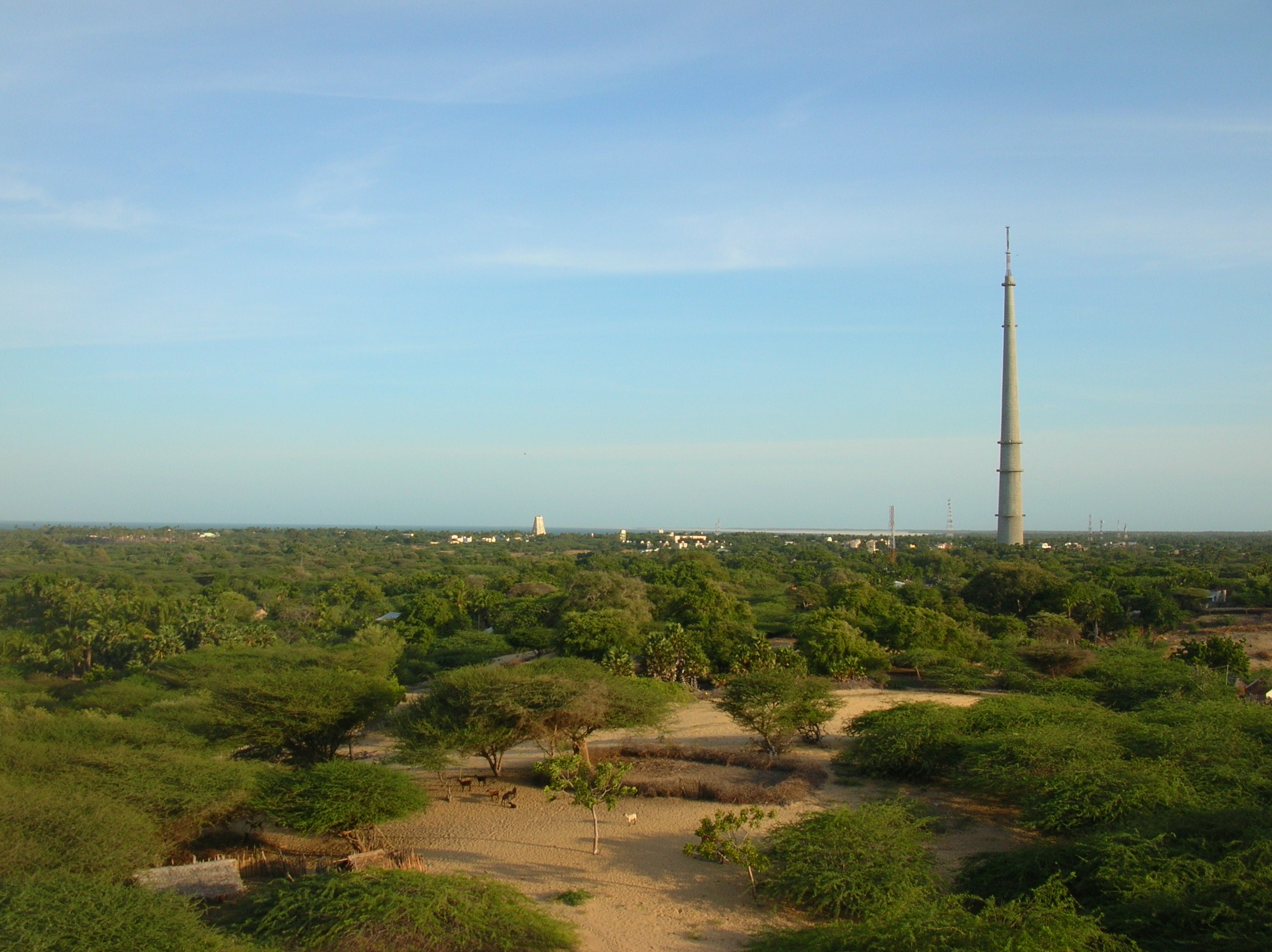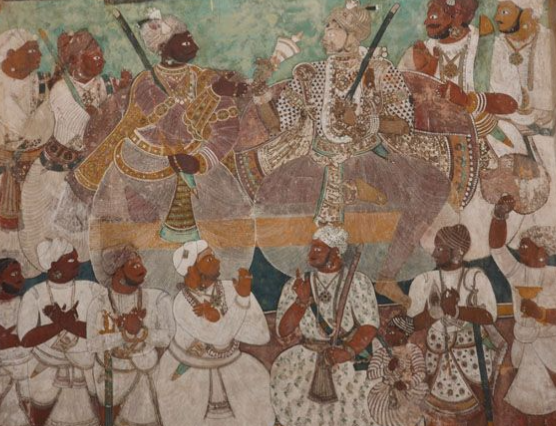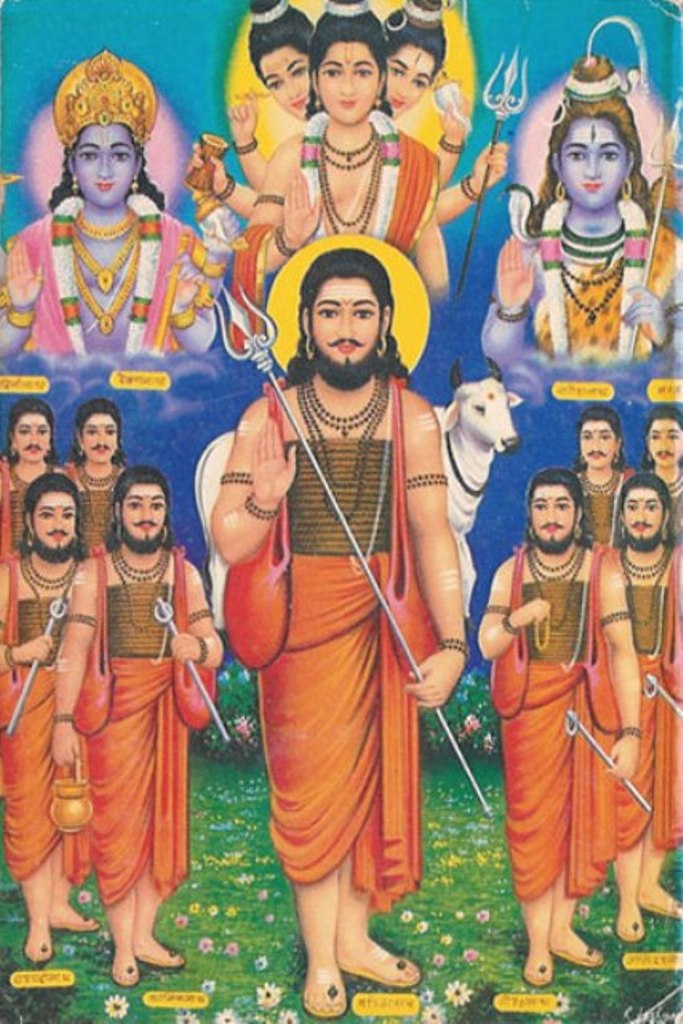|
Mount Gandhamadana
Mt. Gandhamadana is the tallest peak on Pamban Island near Rameswaram, which lies in the Palk Strait between mainland India and Sri Lanka. It is believed by many people that Lord Hanuman resides there. Location Gandhamadana is located 3 kilometres from Rameswaram, almost midway between the western edge of the island and the ghost-town of Dhanushkodi at the corner of the eastern promontory. Legends Mountain Gandhamadana is believed to be the hillock from whose summit, the Rama devotee Hanuman, commenced his flight to Ravana's Lanka. Kalidasa umarasambhava, VIrefers to Gandhamadana, located in the vicinity of the mythical city of Osadhiprastha in the Himalayas, which is home to Santanaka trees. Nath tradition holds that Parashurama, after enacting his vengeance, sought out Dattatreya atop Mount Gandhamadana for spiritual guidance. Their conversations gave rise to Tripura Rahasya The Tripura Rahasya (Devanagari: त्रिपुरा रहस्य, ), also called the ... [...More Info...] [...Related Items...] OR: [Wikipedia] [Google] [Baidu] |
Pamban Island
Pamban Island (, ''pāmpaṉ tīvu''), also known as Rameswaram Island, is an island located between peninsular India and Sri Lanka. It forms part of the Rameswaram taluk in the Ramanathapuram district of the Indian state of Tamil Nadu. It is the largest island in Tamil Nadu by area and the principal town in the island is the pilgrimage centre of Rameswaram. Location and size Pamban Island is situated between 9°11' N and 9°19' N latitude and 79°12' E to 79°23' E longitudes. The chain formed by Pamban Island, the shoals of Adam's Bridge, and Mannar Island of Sri Lanka separate Palk Bay and the Palk Strait in the northeast from the Gulf of Mannar in the southwest. Pamban Island extends for around 30 km in width from the township of Pamban in the west to the remains of Dhanushkodi towards the south-east. The length of the island varies from 2 km at the Dhanushkodi promontory to 7 km near Rameswaram. The area of the island is around 67 km2. Demographics Pam ... [...More Info...] [...Related Items...] OR: [Wikipedia] [Google] [Baidu] |
Rameswaram
Rameswaram (; also transliterated as Ramesvaram, Rameshwaram) is a municipality in the Ramanathapuram district of the Indian state of Tamil Nadu. It is on Pamban Island separated from mainland India by the Pamban channel and is about from Mannar Island, Sri Lanka. It is in the Gulf of Mannar, at the tip of the Indian peninsula. Pamban Island, also known as Rameswaram Island, is connected to mainland India by the New Pamban Bridge. Rameswaram is the terminus of the railway line from Chennai and Madurai. Together with Varanasi, it is considered to be one of the holiest places in India for Hindus and is part of the Char Dham pilgrimage. According to the Ramayana, Rama is described to have built a bridge from the vicinity of this town across the sea to Lanka to rescue his wife Sita from her abductor Ravana. The temple, dedicated to the Hindu god Shiva, is at the centre of the town and is closely associated with Rama and Shiva. The temple and the town are considered a holy pil ... [...More Info...] [...Related Items...] OR: [Wikipedia] [Google] [Baidu] |
Palk Strait
Palk Strait is a strait between the Indian state of Tamil Nadu and Northern Province of Sri Lanka. It connects the Palk Bay in the Bay of Bengal in the north with the Gulf of Mannar in the Laccadive sea in the south. It stretches for about and is wide. It is named after Robert Palk, who was a governor of Madras (1755–1763) during the Company Raj period. Several rivers including the Vaigai flow into the strait. The strait consists of many islands and is interspersed with a chain of low islands and reef shoals that are collectively called Ram Setu or Adam's bridge. The shallow waters and reefs make it difficult for large ships to pass through, although fishing boats and small craft navigate the waters. Dredging the sea to make it deeper for navigation and plans for a bridge over the waters have been proposed. Geography The Palk strait extends between Pamban island in the south eastern tip of the Indian state of Tamil Nadu and Thalaimannar in the Northern Provi ... [...More Info...] [...Related Items...] OR: [Wikipedia] [Google] [Baidu] |
Lord Hanuman
Hanuman (; , ), also known as Maruti, Bajrangabali, and Anjaneya, is a deity in Hinduism, revered as a divine ''vanara'', and a devoted companion of the deity Rama. Central to the ''Ramayana'', Hanuman is celebrated for his unwavering devotion to Rama and is considered a ''chiranjivi''. He is traditionally believed to be the spiritual offspring of the wind deity Vayu, who is said to have played a significant role in his birth. In Shaiva tradition, he is regarded to be an incarnation of Shiva, while in most of the Vaishnava traditions he is the son and incarnation of Vayu. His tales are recounted not only in the ''Ramayana'' but also in the ''Mahabharata'' and various ''Puranas''. Devotional practices centered around Hanuman were not prominent in these texts or in early archaeological evidence. His theological significance and the cultivation of a devoted following emerged roughly a millennium after the ''Ramayana'' was composed, during the second millennium CE.Paula Richman (20 ... [...More Info...] [...Related Items...] OR: [Wikipedia] [Google] [Baidu] |
Pamban Island West MtGandhamadana
Pamban is a town in the Rameswaram taluk of Ramanathapuram district, Tamil Nadu. It is at the west edge of Pamban Island and is a popular fishing port. The town gives its name to the whole island. Pamban railway station is the first station on the island for pilgrims travelling to Rameswaram. Demographics As per the 2011 census, Pamban had a population of 37819 with 19163 males and 18656 females. The sex ratio was 974 and the literacy rate was 85.16%. Climate Pamban has a tropical savanna climate (Köppen climate classification ''As'') with hot summers and cool winters. Unlike most locations in India with this climate, most rainfall occurs in autumn and winter, with the heaviest rain falling from October to December, and very little rain in the summer months of June to August. Transport Pamban Bridge is a long railway bridge which connects the town of Mandapam in mainland India with Pamban Island, and Rameswaram. Opened on 24 February 1914, it was India's first sea brid ... [...More Info...] [...Related Items...] OR: [Wikipedia] [Google] [Baidu] |
Dhanushkodi
Dhanushkodi is an abandoned town at the south-eastern tip of Pamban Island of the state of Tamil Nadu in India. It is south-east of Pamban and is about west of Talaimannar in Sri Lanka. The town was destroyed during the 1964 Rameswaram cyclone and remains uninhabited in the aftermath. Although devoid of inhabitants, Dhanushkodi remains a tourist attraction due to its historical and mythological relevance. Geography Dhanushkodi is on the tip of Pamban island, separated from the Indian mainland by the Palk Strait. Transport The National Highway completed the 9.5-km-long road – 5 km from Mukuntharayar Chathiram to Dhanushkodi and 4.5 km from Dhanushkodi to Arichal Munai. Until 2016, Dhanushkodi was reachable either on foot along the seashore or in jeeps. In 2016, a road was completed from the village of Mukundarayar Chathiram. A metre gauge railway line connected Mandapam on mainland India to Dhanushkodi. Boat mail express ran from Chennai Egmore to Dhanushkodi till ... [...More Info...] [...Related Items...] OR: [Wikipedia] [Google] [Baidu] |
Nath
Natha, also called Nath (), are a Shaivism, Shaiva sub-tradition within Hinduism in India and Nepal. A medieval movement, it combined ideas from Buddhism, Shaivism, Tantra and Yoga traditions of the Indian subcontinent.Natha: Indian religious sect Encyclopedia Britannica (2007) The Naths have been a confederation of devotees who consider Shiva as their first lord or guru, with varying lists of additional gurus. Of these, the 9th or 10th century Matsyendranatha and the ideas and organization mainly developed by Gorakhnath are particularly important. Gorakhnath is considered the originator of the Nath Panth. The Nath tradition has an extensive Shaivism-related theological literature of its own, most of which is ... [...More Info...] [...Related Items...] OR: [Wikipedia] [Google] [Baidu] |
Dattatreya
Dattatreya (, ), Dattā or Dattaguru, is a paradigmatic Sannyasi (monk) and one of the lords of yoga, venerated as an avatar of Lord Vishnu. Three Hindu gods Brahma, Vishnu, and Shiva, who are also collectively known as the Trimurti, incarnated in form of Dattatreya, Chandra and Durvasa as son of Sage Atri and Devi Anusuya as per the texts such as the Bhagavata Purana, the Markandeya Purana, and the Brahmanda Purana. In iconography, he is often represented as a monk with three heads. However sources of the Trimurti's taking avatar in a single body and such iconography is unknown. Several Upanishads are dedicated to him, as are texts of the Vedanta-Yoga tradition in Hinduism. One of the most important texts of Hinduism, Avadhuta Gita (literally, "song of the free soul"), is attributed to Dattatreya. Over time, Dattatreya has inspired many monastic movements in Shaivism, Vaishnavism, and Shaktism, particularly in the Deccan region of India, Maharashtra, Gujarat, Madhya Prades ... [...More Info...] [...Related Items...] OR: [Wikipedia] [Google] [Baidu] |
Tantra
Tantra (; ) is an esoteric yogic tradition that developed on the India, Indian subcontinent beginning in the middle of the 1st millennium CE, first within Shaivism and later in Buddhism. The term ''tantra'', in the Greater India, Indian traditions, also means any systematic broadly applicable "text, theory, system, method, instrument, technique or practice". A key feature of these traditions is the use of mantras, and thus they are commonly referred to as Mantramārga ("Path of Mantra") in Hinduism or Mantrayāna ("Mantra Vehicle") and Guhyamantra ("Secret Mantra") in Buddhism. In Buddhism, the Vajrayana traditions are known for tantric ideas and practices, which are based on Indian Tantras (Buddhism), Buddhist Tantras. They include Tibetan Buddhism, Indo-Tibetan Buddhism, Chinese Esoteric Buddhism, Japanese Shingon Buddhism and Nepalese Newar Buddhism. Although Southern Esoteric Buddhism does not directly reference the tantras, its practices and ideas parallel them. In Bud ... [...More Info...] [...Related Items...] OR: [Wikipedia] [Google] [Baidu] |
Tripura Rahasya
The Tripura Rahasya (Devanagari: त्रिपुरा रहस्य, ), also called the Haritāyana Samhitā, is a medieaval (11th-17th century CE) tantric Shakta Sanskrit text. The title has an ambiguous meaning, translated variously as ''The mystery beyond the three cities'', ''The mystery beyond the trinity'', or ''The secret of the supreme Goddess''. Tripura refers to the 'three cities' of consciousness, namely waking, dreaming and deep sleep, but also to the goddess Tripura Sundari, the prime consciousness underlying these three states. It details the path to liberation, as taught by Dattatreya to Parashurama. Nomenclatura Tripurā means "three towns" or "three places," or "the trinity." The three towns or states of consciousness are waking (Jāgṛat), dreaming (Svapna) and deep sleep (Suṣupti). The underlying consciousness of them all is called Tripura, the goddess Tripura Sundari. Rahasya means "secret" or "mystery," 'keeping secret', referring to the Sanskri ... [...More Info...] [...Related Items...] OR: [Wikipedia] [Google] [Baidu] |
Mountains Of Tamil Nadu
A mountain is an elevated portion of the Earth's crust, generally with steep sides that show significant exposed bedrock. Although definitions vary, a mountain may differ from a plateau in having a limited summit area, and is usually higher than a hill, typically rising at least above the surrounding land. A few mountains are isolated summits, but most occur in mountain ranges. Mountains are formed through tectonic forces, erosion, or volcanism, which act on time scales of up to tens of millions of years. Once mountain building ceases, mountains are slowly leveled through the action of weathering, through slumping and other forms of mass wasting, as well as through erosion by rivers and glaciers. High elevations on mountains produce colder climates than at sea level at similar latitude. These colder climates strongly affect the ecosystems of mountains: different elevations have different plants and animals. Because of the less hospitable terrain and climate, mountains te ... [...More Info...] [...Related Items...] OR: [Wikipedia] [Google] [Baidu] |











